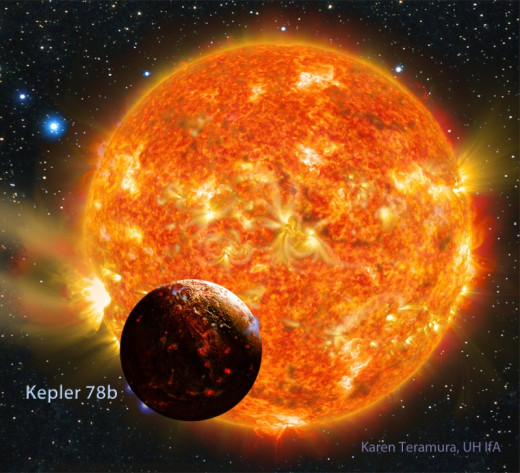MAUNA KEA, Hawaii – The first rocky, earth-sized exoplanet has been discovered, and the historic finding was confirmed by scientists using the Keck Observatory on Mauna Kea.
Kepler-78b, the name of the planet that is 400 light-years from Earth in the constellation Cygnus, was found using data from NASA’s Kepler Space Telescope. Astronomers say the exoplanet orbits its star very closely every 8.5 hours, making it much too hot to support life.
The finding was described in a Keck media release:
| Every 8.5 hours the planet passes in front of its host star, blocking a small fraction of the starlight. These telltale dimmings were picked up by researchers analyzing the Kepler data.The team led by Dr. Andrew Howard (Institute for Astronomy, University of Hawaii at Manoa) then measured the mass of the planet with the Keck Observatory on Mauna Kea, in Hawaii. Using the ten-meter Keck I telescope fitted with the HIRES instrument, the team employed the radial velocity method to measure how much an orbiting planet causes its star to wobble, to determine the planet’s mass. This is another excellent example of the synergy between the Kepler survey, which has identified more than 3,000 potential exoplanet candidates, and Keck Observatory, which plays a leading role in conducting precise Doppler measurements of the exoplanet candidates.
A handful of planets the size or mass of Earth have been discovered recently. This is the first one with both quantities measured. “When you have both the size and the mass of an object, you can calculate its density, and thereby determine its composition,” explained Howard. With a radius about 1.2 times of Earth’s and a mass equal to about 1.7 times Earth’s, Kepler-78b has a density the same as Earth’s, suggesting that it is also made primarily of rock and iron. Its star is slightly smaller and less massive than the sun and is located about 400 light-years from Earth in the constellation Cygnus. Kepler-78b is a member of a new class of “ultrashort period” planets recently identified by the Kepler spacecraft. These newfound worlds all orbit their stars with orbital periods of less than 12 hours. They’re also small, about one-to-two times the size of Earth. Kepler-78b is the first planet in this new class to have its mass measured. It is a mystery how these planets formed and made it so close to their host stars (only 1 percent of the Earth-Sun separation in the case of Kepler-78b). A companion study led by Dr. Francesco Pepe (University of Geneva, Switzerland) used the same Kepler data but independent radial velocity observations and is being published in the same issue. The two studies found similar results. “The gold standard in science is having your findings reproduced by other researchers,” explained Howard. “In this case, we did not have to wait for this to happen.” The other members of Howard’s team are Roberto Sanchis-Ojeda (MIT), who analyzed the transit data taken by the Kepler spacecraft to find the planet and calculate its size, Dr. Geoffrey Marcy (University of California, Berkeley), Dr. John Johnson (Harvard), Dr. Debra Fischer (Yale), Benjamin Fulton and Evan Sinukoff (UHM graduate students), and Dr. Jonathan Fortney (University of California, Santa Cruz). HIRES (the High-Resolution Echelle Spectrometer) produces spectra of single objects at very high spectral resolution, yet covering a wide wavelength range. It does this by separating the light into many “stripes” of spectra stacked across a mosaic of three large CCD detectors. HIRES is famous for finding planets orbiting other stars. Astronomers also use HIRES to study distant galaxies and quasars, finding clues to the Big Bang. The W. M. Keck Observatory operates the largest, most scientifically productive telescopes on Earth. The two, 10-meter optical/infrared telescopes on the summit of Mauna Kea on the Island of Hawaii feature a suite of advanced instruments including imagers, multi-object spectrographs, high-resolution spectrographs, integral-field spectroscopy and world-leading laser guide star adaptive optics systems. The Observatory is a private 501(c) 3 non-profit organization and a scientific partnership of the California Institute of Technology, the University of California and NASA. |


by Big Island Video News8:14 am
on at
STORY SUMMARY
MAUNA KEA, Hawaii – The first rocky, earth-sized exoplanet has been discovered, and the historic finding was confirmed by scientists using the Keck Observatory on Mauna Kea. Kepler-78b, the name of the planet that is 400 light-years from Earth in the constellation Cygnus, was found using data from NASA’s Kepler Space Telescope. Astronomers say the […]